Production technology and application of fermented tapioca starch for baking
A tapioca starch and baking technology, applied in application, fermentation, treatment of microorganisms with electricity/wave energy, etc., can solve problems such as differences in product quality, irregular fermentation process conditions, poor product stability, etc., to achieve a short production cycle, eliminate The effect of multi-strain mixed toxin danger and gel structure strength improvement
- Summary
- Abstract
- Description
- Claims
- Application Information
AI Technical Summary
Problems solved by technology
Method used
Image
Examples
Embodiment 1
[0058] (1) Use molasses (calculated according to the available glucose content) to prepare a fermentation medium with a content of 0.5g / 100g, sterilize at high temperature and high pressure, the temperature range is controlled at 115°C, the pressure range is controlled at 0.2MPa, and the sterilization time is controlled at 20min.
[0059] (2) The medium of the seed liquid was Lactobacillus medium (MRS broth medium), the strain was Lactobacillus plantarum (CCTCCM2017138), the fermentation temperature was 37°C, and the fermentation time was 12h. After the fermentation medium is cooled to 25°C, tapioca starch is added in a clean environment, and the addition amount is 50% of the quality of the medium, stirred and modulated into starch milk, and the fermented seed liquid is moved into the fermentation medium, and the inoculation amount is starch milk. 10% of the mass. The fermentation temperature was 37°C and the fermentation time was 96h.
[0060] (3) Wash starch milk to pH 5 a...
Embodiment 2
[0063] With reference to Example 1, the addition of molasses (calculated by the available glucose content) was replaced by 0g / 100g, 1.0g / 100g, 1.5g / 100g, 2.0g / 100g, and other conditions were unchanged, and the fermented tapioca starch was prepared. . The production time of the whole process is 5d. The performance results of the obtained products are shown in Tables 1, 2, and 3.
[0064] The gelatinization viscosity characteristics of fermented tapioca starch obtained with different amounts of carbon sources were measured, and the results are shown in Table 1. It can be seen from Table 1 that compared with native starch, the peak viscosity, trough viscosity, final viscosity and retrogradation value of tapioca starch after fermented light were significantly decreased, from 1651 mPa s, 796.5 mPa s, 1301.0 mPa s and 504.5 mPa s, respectively. mPa·s decreased to around 1100mPa·s, 300mPa·s, 450mPa·s and 150mPa·s. The disintegration value changed little and decreased by about 10-3...
Embodiment 3
[0074] (1) Use molasses (calculated according to the available glucose content) to prepare a fermentation medium with a content of 1.0g / 100mL, high temperature and high pressure sterilization, the temperature range is controlled at 115°C, the pressure range is controlled at 0.2MPa, and the sterilization time is controlled at 20min.
[0075] (2) The medium of the seed liquid is lactic acid bacteria medium (MRS broth medium), the strain is Lactobacillus plantarum (CCTCCM2017138), the fermentation temperature is 37°C, and the fermentation time is 12h; after the fermentation medium is cooled to 25°C , in a clean environment, add tapioca starch, the addition amount is 50% of the quality of the medium, stir to prepare starch milk, transfer the fermented seed liquid into the fermentation medium, and replace the inoculum with 0.5% and 5% of the quality of the starch milk. , 15%, 30%, the fermentation temperature is 37℃, and the fermentation time is 96h.
[0076] (3) Wash the starch m...
PUM
 Login to View More
Login to View More Abstract
Description
Claims
Application Information
 Login to View More
Login to View More - R&D
- Intellectual Property
- Life Sciences
- Materials
- Tech Scout
- Unparalleled Data Quality
- Higher Quality Content
- 60% Fewer Hallucinations
Browse by: Latest US Patents, China's latest patents, Technical Efficacy Thesaurus, Application Domain, Technology Topic, Popular Technical Reports.
© 2025 PatSnap. All rights reserved.Legal|Privacy policy|Modern Slavery Act Transparency Statement|Sitemap|About US| Contact US: help@patsnap.com



